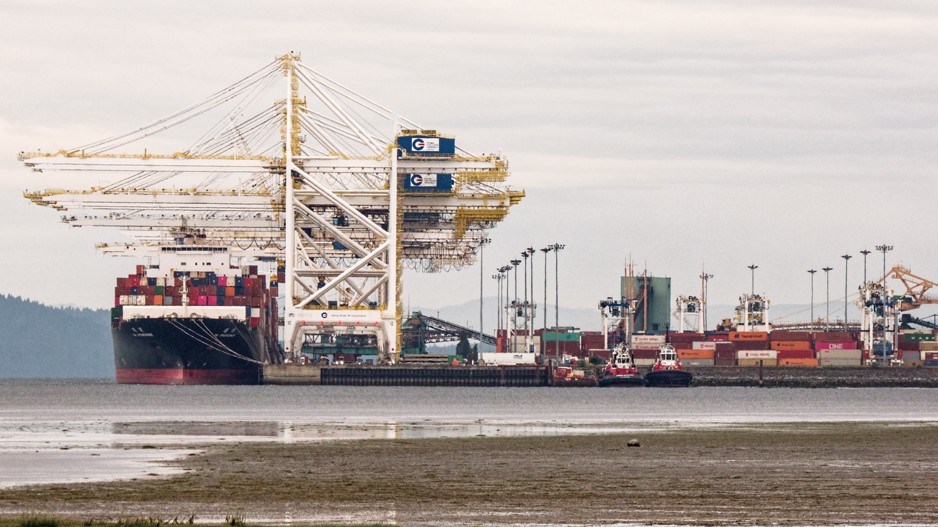The Vancouver Fraser Port Authority’s (VFPA) controversial bid to expand Roberts Bank’s container cargo handling capacity is back on track after it responded to the federal environment ministry’s order to produce more information on how the port plans to reduce the project’s impact on wildlife habitat and local communities.
Ottawa will now invite public comment (until Feb. 13) on the port authority’s findings and Impact Assessment Agency of Canada’s (IAAC) newly released “potential conditions” for approving the $3.5 billion Roberts Bank Terminal 2 project (RBT2).
In a statement, VFPA Vice-President of Infrastructure Cliff Stewart said the response is a major step forward for a project sorely needed to address the port’s container cargo capacity crunch.
The project has been mired in a decade-long environmental assessment process and faces vocal opposition from municipal governments in Richmond and Delta, as well as environmentalists, First Nations communities and even Roberts Bank’s current container-terminal tenant, GCT Global Container Terminals Inc. It would double the size of the existing 85-hectare container facility by landfill and add an estimated 2.4 million 20-foot-equivalent units (TEUs) to the Port of Vancouver’s container handling capacity.
But the proposed expansion could affect up to 177 hectares of the sensitive Fraser River estuary – which opponents say would be irreparably damaged as a habitat for migrating birds and sea creatures like killer whales. Concerns have also been raised about the project’s effect on human health and First Nations communities’ access to the Delta coastline for maintaining their traditional lifestyle.
Meanwhile, GCT – which operates Roberts Bank’s GCT Deltaport container terminal – has proposed a rival expansion project (Berth 4 or DP4) that the operator argues is more “right-sized” in minimizing environmental impact while fulfilling future capacity demands at a lower cost. GCT and the VFPA have been locked in legal dispute over the two projects.
The VFPA, in its response to the environment ministry, updated its plan on how to mitigate RBT2’s environmental impact by tripling its original commitment for habitat creation to 86 hectares for species like chinook salmon and dungeness crab. That, the port authority says, is 22 hectares more “than what is required to counterbalance the effects of the project that would remain after implementation of avoidance and reduction measures.”
Other new measures, according to the VFPA response, include:
•avoiding noisy construction during peak killer whale season;
•controlling underwater noise during operations;
•working with Indigenous communities on planning of proposed projects; and
•creating habitat projects focused on specific species.
The port authority also updated RBT2’s economic impact estimates, which include $1.6 billion in labour income, $519 million in tax revenue and $2.3 billion in GDP during the construction phase alone.
Once RBT2 is operational, the port projects an annual GDP contribution of $3 billion to the Canadian economy. The project’s cost has been estimated at between $2 billion and $3.5 billion.
Both GCT and community opponents remain skeptical of VFPA’s response.
GCT Canada vice-president of public affairs Marko Dekovic said the company will submit a comment to the IAAC, reaffirming the operator’s opposition to RBT2.
Dekovic repeated GCT’s claim that DP4 would be a better fit for Canada’s container cargo needs projections, adding that the recent flooding-driven bottlenecks were created in other links in the supply chain – and not in the existing container terminal capacity itself.
Dekovic also questioned RBT2’s uncertain cost – including the need to secure another operator for the new terminal. The VFPA has stated it wants a different container terminal operator at RBT2 to create competitive pricing and improve costs incurred by vessels looking to dock at Roberts Bank.
“Why would the Vancouver Fraser Port Authority continue pushing for a decades-old outmoded megaproject that would be publicly funded and environmentally devastating instead?” Dekovic said. “The port should be stepping back, focusing on its core mandate, and allowing the private sector to handle this private-sector matter.”
Meanwhile, Roger Emsley, executive director of the Against Port Expansion Community Group, said in an email that he is especially disappointed in the IAAC’s draft conditions for approving Terminal 2 – which include continued engagements with local stakeholders and annual reports to monitor the project’s environmental promises and performances.
“What you may not be aware of is just how deficient are the draft conditions,” Emsley said. “The IAAC-developed draft conditions really are a joke. Basically, the VFPA is required to consult, monitor, mitigate, followup and report. There is no stopping or changing the project – even if bird populations show declines and/or ultimately go extinct.”
The full VFPA response and the IAAC’s draft RBT2 conditions can be read at iaac-aeic.gc.ca/050/evaluations/proj/80054.




